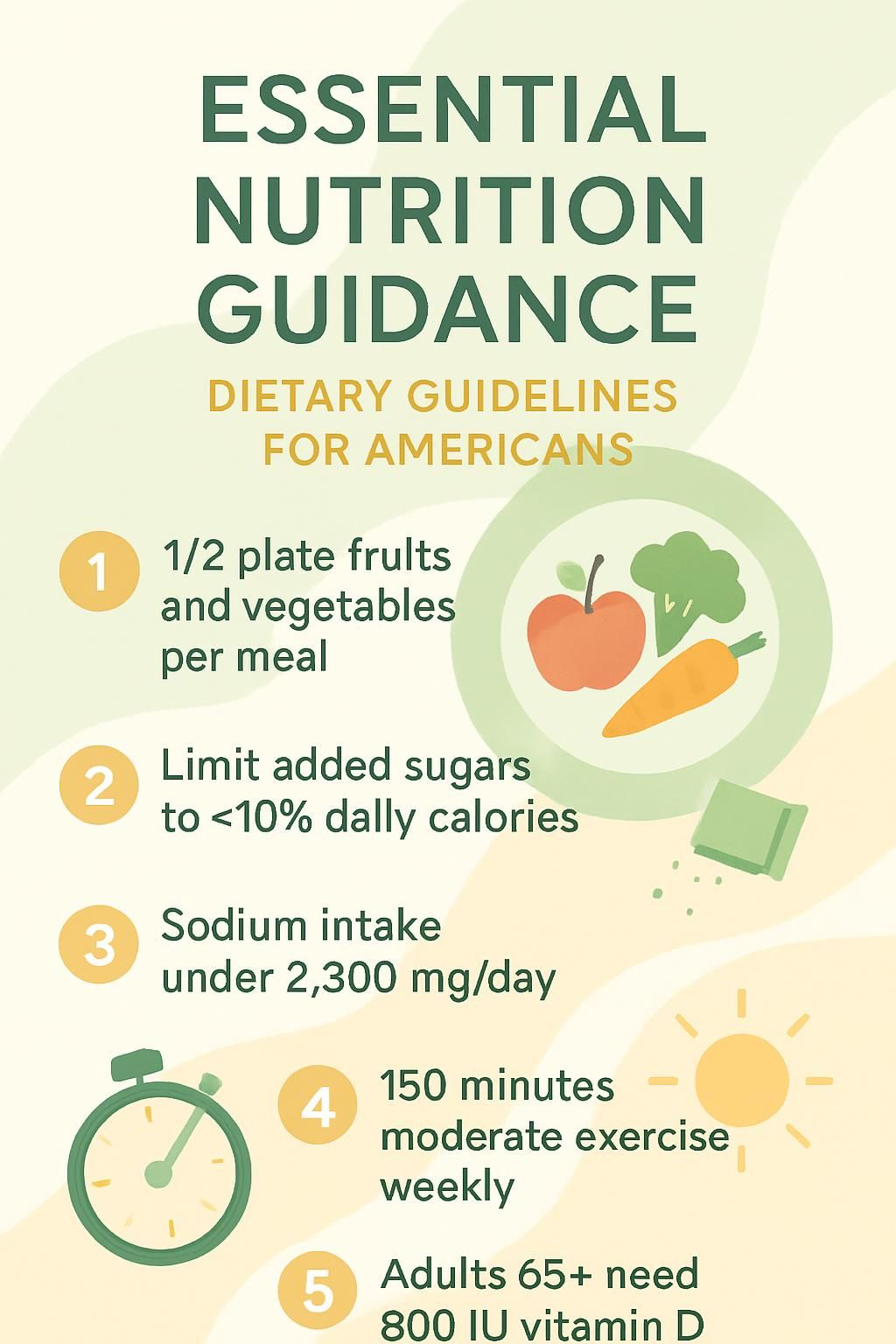Essential Nutrition Guidance: Dietary Guidelines For Americans
Our Nutrition Assistant AI Suite will transform your body. You will lose fat, get toned, and build muscle. Gain confidence and optimal health.
Sorting through food advice can feel confusing. The Dietary Guidelines for Americans give you clear, science-based steps for healthy eating backed by the USDA and HHS. Use this guide to turn that advice into everyday choices that fit your routine.
You will learn how to plan a balanced diet, understand portions, and meet your nutrient needs without guesswork. The tips are practical, budget friendly, and easy to apply at home. This article is for education, not personalized medical advice. Speak with your healthcare professional if you have medical conditions or special dietary needs.
Key Takeaways
- At each meal, aim for half your plate fruits and vegetables, one quarter whole grains, and one quarter lean protein.
- Limit added sugars to less than 10% of daily calories and keep sodium under 2,300 milligrams per day.
- Choose nutrient-dense foods such as whole fruits, vegetables, beans, low-fat dairy, fish, or poultry instead of processed snacks high in trans fat or added sugars.
- Kids and teens need more nutrients per pound; pregnancy increases needs for folic acid, iron, calcium, iodine, and choline; adults 65+ often need more vitamin D and calcium.
- Pair nutrition guidance with at least 150 minutes of moderate activity weekly for adults, as recommended by the CDC.

Overview of the Dietary Guidelines for Americans

The Dietary Guidelines for Americans outline smart choices for healthy eating and drinking. Health professionals use these standards to shape programs and public health messages across the United States.
What Are the Purpose and Objectives of the Dietary Guidelines?
Experts from the United States Department of Agriculture and the Department of Health and Human Services developed these guidelines to help you meet nutrient needs, support health, and reduce chronic disease risk. The guidance updates every five years to reflect the strongest available science.
The 2020–2025 edition covers every life stage, from birth through older adulthood. You are encouraged to build meals around fruits and vegetables, whole grains, dairy such as low-fat milk or yogurt, and lean proteins like fish, poultry, beans, and lentils. MyPlate offers a simple visual to plan balanced meals for the entire family.
A doctor once suggested I cut foods high in saturated fat. After swapping to leaner options and more vegetables, my energy improved during work and exercise.
How Have the Dietary Guidelines Evolved Over Time?
The first guidelines appeared in 1980 and emphasized eating more fruits, vegetables, and whole grains while limiting fat, sugar, and salt. As research advanced, updates refined topics like dietary cholesterol. For example, evidence showed that cholesterol from foods like eggs has a smaller effect on blood cholesterol than once thought[1].
The 2020–2025 guidance stresses nutrient-dense choices, such as beans, brown rice, yogurt, and lean fish or poultry. It favors low-fat or reduced-fat dairy to support bone health while limiting saturated fat. Plant-forward options like lentils and whole-wheat pasta help raise fiber intake. Newer versions also urge cutting sweetened beverages and eliminating trans fats to lower heart disease risk. These shifts reflect current nutrition science aimed at reducing obesity and disease tied to heavily processed foods.
Next comes an explanation of essential principles for a healthy diet.
Source:
1: U.S. Department of Health & Human Services; Dietary Guidelines Advisory Committee reports
Essential Principles for a Healthy Diet
Core principles make it easier to build meals rich in vitamins and minerals. They also help you meet your daily needs without excess calories.
Why Should I Emphasize Fruits, Vegetables, and Whole Grains?
Fruits, vegetables, and whole grains deliver fiber, vitamin C, potassium, folate, and many other nutrients. Eating a variety, at least five servings a day, is linked to lower risk of heart disease and some cancers. Fiber supports healthy digestion and can help you feel full longer.
Whole grains like oatmeal, brown rice, and whole-wheat bread are steady energy sources. They can replace snacks high in fat, salt, and sugar. Many people find that building meals around produce and grains helps control appetite and maintain a healthy weight.
Choose a colorful mix of foods to cover key nutrients and protect long-term health.
I added dark leafy greens to my lunch a few days a week. Energy stayed steadier through the afternoon with no need for extra sugar or salt.
How Can I Include Lean Proteins and Plant-Based Foods?
Protein supports muscles, skin, and immune function. Good sources include skinless chicken, lean beef cuts like sirloin, fish such as salmon or tuna, eggs, low-fat yogurt, tofu, beans, peas, and lentils. Beans and lentils also deliver fiber, which supports heart health.
Build variety across the week. Add beans to salads, try lentil chili, or set a simple Meatless Monday. My family swapped chicken for chickpeas in a stir-fry, and costs stayed similar while fiber increased.
Pick fresh or minimally processed choices when you can. Swap sausage for grilled fish, or use black beans on taco night. These small changes lower sodium and saturated fat without losing flavor.
What Are Unsaturated Fats and Why Choose Them?
Unsaturated fats are fats that tend to stay liquid at room temperature. They support heart health by lowering LDL cholesterol, the type that can build up in arteries. Sources include olive oil, canola oil, sunflower oil, nuts, seeds, avocados, and oily fish like salmon and mackerel.
Replace butter or lard with plant oils for cooking. Healthy fats also help you absorb vitamins A, D, E, and K. I switched to olive oil for most sautéing. Meals tasted great and felt lighter.
How Do I Reduce Added Sugars, Sodium, and Trans Fats?
Cutting added sugars, sodium, and trans fats is one of the strongest moves you can make for long-term health. Trans fats are industrial fats formed during hydrogenation, and they raise LDL while lowering HDL, the protective cholesterol.
- Read labels for added sugars, sodium, and words like
partially hydrogenated
which signal trans fat. - Choose fruit or yogurt for snacks instead of candy or pastries. Whole fruit adds fiber and natural sweetness.
- Cook at home more often. Season with herbs, spices, citrus, or vinegar instead of extra salt or sauces.
- Limit soda and sweetened drinks. Water should be your main beverage.
- Choose whole-grain products that are lower in sodium and free of trans fats.
- Pick lean cuts of meat and skip deep-fried foods cooked in solid fats.
- Keep portions of salty foods like chips or processed cheese small.
- Use olive or canola oil in place of butter.
- Check current guidance on government websites for daily limits on sugar and salt.
- Pick dried fruit without added sugar and keep portions small, since sugars are concentrated.
Eating less added sugar and salt reduces health risks including obesity, hypertension, diabetes, and heart disease according to the 2020–2025 Dietary Guidelines for Americans published by government agencies including USDA and HHS[1].
[1] U.S. Department of Agriculture (USDA), U.S. Department of Health & Human Services (HHS). Dietary Guidelines for Americans 2020–2025
Why Is Hydration Important for Health?
Water makes up about 60% of your body weight. It regulates temperature, carries nutrients, cushions joints, and removes waste. A common target is 2 to 3 liters of fluids per day from food and drinks. Needs rise with exercise, hot weather, or illness.
High-water foods like fruit and vegetables can help. In college, I kept a refillable bottle in class after morning runs. Staying hydrated helped me focus and kept energy steady.
How to Build a Balanced Diet
Balanced meals include a mix from each food group. This approach supports health at any age and makes daily choices simpler to manage.
What Is the Healthy Eating Plate Concept?
The Healthy Eating Plate is an easy portion guide. Fill half your plate with fruits and vegetables, one quarter with whole grains, and one quarter with lean protein such as fish, beans, or poultry. Choose whole fruit over juice to get more fiber. Drink water most of the time.
Include small amounts of healthy oils and avoid trans fats and excess butter. Many parents use the same layout for kids, which helps children get a good mix without strict meal plans.
How Can I Manage Portions and Caloric Intake Effectively?
Portion control supports weight goals and reduces overeating. A few simple steps keep it manageable.
- Use smaller plates or bowls to limit portions without feeling deprived.
- Follow the plate method: half produce, one quarter whole grains, one quarter lean protein.
- Check the label for serving size and calories.
- Favor higher fiber foods like brown rice, beans, and whole-wheat bread.
- Eat slowly so your body can signal fullness.
- Pre-portion snacks instead of eating from the bag.
- Drink water before meals to help with appetite control.
- Swap sugary drinks for water or unsweetened options.
- Notice true hunger cues and pause if you are eating from habit.
- Pick nutrient-dense snacks such as fruit with nut butter or yogurt.
I tracked my meals for two weeks with an app. Seeing the numbers helped me spot patterns and adjust portions.
Why Is Variety Important in Nutrient-Dense Foods?
Variety helps you cover more nutrients. Fruits and vegetables bring vitamin C and potassium. Lean meats and beans supply iron and protein. Rotating choices prevents gaps and keeps meals interesting.
Try tofu or beans some days, lean chicken or fish on others. My toddler likes trying new colorful produce. Variety builds healthy habits without boredom.
Analyzing the 2020–2025 Dietary Guidelines
The 2020–2025 Dietary Guidelines highlight nutrient density, which means more nutrients per calorie. This focus helps you meet needs while limiting added sugars and saturated fat.
How Does Prioritizing Nutrient Density Benefit My Diet?
Nutrient-dense foods give you vitamins, minerals, and fiber without unnecessary calories. Think whole fruit instead of juice or salmon instead of processed meat. This pattern helps you meet targets while avoiding excess sodium and sugar.
When I centered meals on vegetables and whole grains, I felt full longer and had steadier energy. Diets higher in nutrient density are linked with lower risk of heart disease and type 2 diabetes.
What Nutritional Guidance Is Recommended for Different Life Stages?
Children need nutrient-rich meals for growth and learning. Offer fruits, vegetables, whole grains, dairy or fortified alternatives, and lean proteins daily. Teens need extra calcium, iron, and vitamin D during growth spurts.
Adults should match intake to activity levels. In older age, nutrient-dense foods help keep calories balanced while supporting bone, muscle, and digestive health. During pregnancy and breastfeeding, needs increase for folate, iron, choline, iodine, calcium, protein, and fluids. Talk with a clinician or registered dietitian if you have questions about supplements.
Nutrient density benefits every life stage and helps prevent deficiencies.
Which Strategies Help Minimize Chronic Disease Risks?
Build most meals around fruits, vegetables, whole grains, and lean proteins. Choose unsaturated fats from nuts, seeds, avocados, and olive oil to support heart health. Limit added sugars, sodium, and trans fats to reduce risk for heart disease and diabetes.
Regular physical activity works with nutrition. Aim for at least 150 minutes of moderate exercise each week. Reading labels helps you avoid hidden sugars and sodium that raise risk over time.
Practical Guidance for Applying the Guidelines
Turning nutrition advice into daily habits starts with simple planning. Small steps add up and become routine.
How Do I Plan Balanced Meals?
Focus on nutrient-dense foods and colorful variety at each meal.
- Fill half your plate with fruits and vegetables.
- Make at least half your grains whole grains such as brown rice, oats, or whole-wheat bread.
- Include lean proteins like chicken, fish, beans, or tofu.
- Add low-fat dairy or fortified soy alternatives for calcium and vitamin D.
- Cook with healthy oils such as olive or canola oil.
- Keep added sugars under 10% of daily calories.
- Limit sodium to less than 2,300 milligrams per day.
- Check labels for saturated and trans fat.
- Keep meals varied across the week to cover different nutrients.
- Drink water through the day for hydration.
How Can I Understand Food Labels?
Labels help you compare foods quickly and make informed choices.
- Start with serving size, since packages often contain more than one serving.
- Check calories per serving to manage intake.
- Use Percent Daily Value, or %DV, to see if a food is high or low in a nutrient.
- Limit saturated fat, trans fat, cholesterol, sodium, and added sugars.
- Look for fiber, vitamin D, calcium, iron, and potassium, which many people lack.
- Compare brands using the same serving size.
- Scan the ingredient list. Ingredients appear in order by weight.
- Treat claims like
low fat
orsugar-free
carefully and confirm with the Nutrition Facts. - Practice at the store. Quick label checks soon become a habit.
- Stay informed as labeling rules evolve and presentation improves.
Food labels put you in control of your nutrition goals, one purchase at a time.
What Are Healthier Cooking Techniques?
Cooking methods affect calories, fat, and sodium. Choose techniques that keep flavor and nutrients while limiting extras.
- Grill meats or vegetables for big flavor with little added fat.
- Steam vegetables to preserve vitamin C and keep color bright.
- Sauté with a small amount of olive oil instead of butter.
- Bake or roast to develop natural flavors while using less oil.
- Poach eggs, fish, or chicken in broth or water to keep protein lean.
- Season with herbs, spices, lemon, or vinegar instead of extra salt.
- Stir-fry quickly with lean proteins and colorful vegetables.
- Make soups with low-sodium broth and add beans and whole grains.
- Trim visible fat and remove poultry skin before cooking.
These steps align with the guidelines and make healthy cooking easier to sustain.
How Do I Choose Nutrient-Dense Snacks?
Snacks can fill nutrient gaps and steady your energy. Keep them simple and satisfying.
- Pick fruits, vegetables, or unsalted nuts for vitamins and minerals.
- Choose fiber-rich options like whole-grain crackers or popcorn.
- Add protein with low-fat yogurt, cottage cheese, or hard-boiled eggs.
- Include healthy fats with avocado slices or a small handful of almonds.
- Limit added sugars by choosing fresh produce or no added sugar items.
- Watch sodium in packaged snacks and compare labels.
- Pre-portion snacks to avoid overeating.
- Prep at home, like carrots with hummus, to control ingredients.
- Favor short ingredient lists to avoid additives and extra calories.
Prepping cut vegetables on Sunday helped me skip chips after work. A few minutes saved me money and improved my choices.
Dietary Needs for Special Populations
Nutrient needs vary across life stages. Adjusting your plate helps support growth, performance, and healthy aging.
What Are the Nutrition Needs of Children and Adolescents?
Children and teens need more nutrients per pound to support growth, learning, and bone development. Build three balanced meals with snacks that include produce, lean proteins, dairy or fortified alternatives, whole grains, and healthy fats.
Calorie needs vary with age, growth, and activity. Many boys ages 9 to 13 need about 1,600 to 2,600 calories daily. Many girls in the same range need about 1,400 to 2,200. Iron supports growth during the teen years, and vitamin D helps build strong bones. Limit sugar-sweetened drinks to protect health and energy.
How Should Pregnant and Lactating Women Approach Nutrition?
During pregnancy and breastfeeding, your body needs more nutrients to support both you and the baby. Increase folic acid, iron, calcium, iodine, choline, protein, and fluids. The CDC advises at least 400 micrograms of folic acid daily to help prevent certain birth defects.
Choose lean proteins like eggs, beans, salmon or tilapia, nuts, and low-fat dairy. Aim for 8 to 12 cups of fluids daily while nursing. Limit added sugars and high-sodium foods. Avoid alcohol during pregnancy and keep caffeine under about 200 milligrams per day unless your clinician advises differently.
What Are Dietary Considerations for Older Adults?
As you age, the body may absorb vitamin B12, calcium, and vitamin D less efficiently. Choose foods rich in these nutrients, such as fortified cereals, dairy, leafy greens, eggs, and fish. Many older adults benefit from about 1,000 milligrams of calcium and 800 IU of vitamin D per day, based on guidance for bone health.
Lean proteins like poultry, fish, beans, or tofu help maintain muscle. Drink water regularly since thirst declines with age. Limit sodium by choosing fresh foods and low-sodium options to support healthy blood pressure. Dietary fiber from whole grains, fruits, and vegetables supports digestion.
Integrating Physical Activity with Nutrition
Think of food as fuel and movement as the spark. Together they help you feel and perform better.
Why Is Regular Exercise Important?
Regular activity helps your body use the nutrients you eat. It supports heart health, builds muscle, and strengthens bones. The CDC advises at least 60 minutes of activity daily for kids and teens, and at least 150 minutes per week of moderate exercise for adults.
Movement also lowers risk of type 2 diabetes, high blood pressure, and some cancers. Many people report less stress and better sleep when they stay active. Good nutrition and exercise work best as a team.
Summary: Routine activity strengthens the body and mind, lowers disease risk, and pairs well with balanced nutrition.
How Do Diet and Physical Activity Work Together?
Carbohydrates provide quick energy for exercise. Protein helps repair muscles afterward. Hydration regulates temperature and protects joints. Eating calcium-rich foods like yogurt along with weight-bearing activities, such as brisk walking, supports strong bones.
Active people often sleep better and manage weight more easily. Combining smart meals with steady movement is a reliable path to long-term health.
Resources for Healthy Eating
Simple tools can help you plan meals and stick with healthy habits day after day.
What Are MyPlate and the Start Simple App?
MyPlate shows five food groups on one plate: fruits, vegetables, grains, protein foods, and dairy. Filling half your plate with fruits and vegetables increases nutrients without many calories. The Start Simple app from USDA turns goals into daily actions, like choosing more whole grains or drinking more water.
Set small targets and track them with checklists and reminders. Many families use these tools to build lasting habits.
Next, learn how to stretch your budget while staying on track.
How Can I Eat Well on a Budget?
Healthy eating does not have to cost more. A plan and a list make a big difference.
- Plan weekly meals to avoid impulse buys.
- List affordable staples like whole grains, dried beans, frozen vegetables, and in-season fruit.
- Compare unit prices to find the best value.
- Choose store brands, which often match nutrition at a lower price.
- Buy larger packages of staples to cut the cost per serving.
- Cook at home most days to control ingredients and portions.
- Use leftovers for soups, salads, or wraps.
- Drink tap water instead of sugary drinks.
- Batch-cook meals like chili or casseroles for future lunches.
- Use sales, coupons, and loyalty rewards.
- Check farmers markets near closing for produce discounts.
Last month I stuck to a list with beans, brown rice, seasonal apples, carrots, eggs, and bulk oats. My weekly bill dropped by about 30% while the quality of my meals improved.
Where Can I Find Easy Recipes and Meal Planning Tips?
Trusted sources make planning easier and keep meals balanced.
- MyPlate’s recipe hub shares quick ideas for all ages.
- The Start Simple with MyPlate app offers weekly tips and shopping lists.
- USDA resources provide budget-friendly recipes and sample menus.
- Hospitals and public health sites publish meal plans and printable guides.
- Cookbooks by registered dietitians follow evidence-based guidance.
- Grocery websites often feature simple recipes using seasonal produce.
- Video tutorials show fast, nutritious cooking. A 10-minute veggie stir-fry saved my busy weeknight.
- Local extension offices teach cooking skills and nutrition basics.
- Health-focused blogs share practical batch-cooking and prep ideas.
- Apps like Yummly or Mealime filter recipes by goals and time.
- The American Heart Association hosts a large library of lower-sodium recipes.
Advantages of Adhering to the Dietary Guidelines
Following the Dietary Guidelines for Americans supports a healthier body and mind. Even small changes to your plate can pay off.
How Does Following the Guidelines Boost Health and Well-being?
Building meals around vegetables, fruits, and whole grains can lower heart disease risk. Keeping added sugars under 10% of daily calories helps with weight management and stable blood sugar. Many people report steadier energy and focus when they follow a balanced diet.
In my case, replacing sugary drinks with water improved focus within a week. People who eat more whole foods often have fewer sick days and better mood.
Summary: Evidence-based nutrition choices support a stronger body, clearer thinking, and long-term health.
How Can the Guidelines Reduce Chronic Disease Risks?
Choosing whole grains, fruits, vegetables, lean proteins, and healthy fats helps control blood pressure and cholesterol. Cutting processed foods high in sodium and added sugars reduces risk of heart disease and type 2 diabetes. Swapping sweet drinks for water is a simple step that lowers daily calories.
Small, steady changes add up over time and protect your health as you age.
How Do They Enhance Energy and Vitality?
Meals rich in produce, whole grains, and lean proteins support steady blood sugar. Complex carbohydrates like oats and brown rice release energy slowly. Nutrient-dense snacks such as yogurt or nuts help you power through the afternoon. Hydration boosts focus and helps your body carry nutrients where they are needed.
I noticed less afternoon fatigue after adding more vegetables and whole grains to lunch. Consistent choices lead to lasting energy.
Overcoming Challenges to Healthy Eating
Many people hit roadblocks on the path to healthy eating. Practical solutions can keep you moving forward.
What Are Common Barriers to Nutritious Diets and How Can I Overcome Them?
- Limited time: batch-cook or prep simple recipes in advance for busy days.
- Rising costs: buy in-season produce, compare prices, and use coupons or apps.
- Confusing advice: rely on evidence-based sources like the Dietary Guidelines for Americans.
- Lack of cooking skills: start with easy recipes and learn from short videos.
- Stress eating: take a walk, call a friend, or journal instead of snacking.
- Limited access to fresh foods: choose frozen or canned options without added sugar or salt.
- Family preferences: involve everyone in planning and shift recipes gradually.
- Workplace temptations: bring nuts, yogurt, or fruit for meetings and breaks.
- Allergies or intolerances: read labels carefully and seek guidance from a registered dietitian.
Understanding common myths will also help you make better choices.
What Are Some Common Nutrition Myths Debunked?
- Carbs always cause weight gain. Whole grains, fruits, and vegetables bring fiber and key nutrients.
- You need supplements instead of real food. Most people can meet needs with a balanced diet.
- Fat-free means healthier. Unsaturated fats in olive oil or nuts support heart health when used instead of saturated fat or trans fat.
- Plant-based diets lack protein. Beans, lentils, tofu, and nuts provide plenty.
- Fruit sugar is the same as added sugar. Fruit includes fiber and micronutrients that support health.
- Detox diets are required. Your liver and kidneys already handle detoxifying.
- Eating late at night always causes weight gain. Total daily intake matters most.
- Gluten-free foods are always better. If you do not need them, they can be lower in nutrients.
- Eggs should be avoided. For most people, eggs in moderation fit a balanced diet.
- Skipping breakfast is required for fat loss. Many people do better with a balanced morning meal.
Looking Ahead: The 2025–2030 Dietary Guidelines
Experts expect the next update to reflect new science on nutrition patterns and health. The goal remains the same, support healthy eating for all Americans.
What Updates and New Emphases Are Expected?
The 2025–2030 Dietary Guidelines may place stronger focus on plant-forward eating and sustainability. Guidance could address reducing ultra-processed foods and provide clearer advice on sugar substitutes and alcohol. You may also see more attention to personalization based on age, culture, and preferences, along with strategies for food affordability.
What Is New in Nutritional Science?
Research shows dietary fiber plays a key role in gut health, weight control, and heart health. Studies link ultra-processed foods with challenges in metabolism and mood. Plant proteins support muscle while lowering saturated fat intake.
Scientists are studying how the gut microbiome responds to different plant foods. Interest in personalized nutrition is growing. Hydration research also suggests even mild dehydration can affect mood and focus.
Conclusion
You can shape your health with the Dietary Guidelines for Americans. Focus on fruits and vegetables, whole grains, lean proteins, low-fat dairy, and healthy fats. Keep added sugars and sodium in check, and pair your meals with regular activity.
Start with one step, such as making half your plate fruits and vegetables or swapping soda for water. Small changes build momentum. Your future self will benefit from the steady progress you make today.
FAQs
1. What are the main goals of the Dietary Guidelines for Americans?
The Dietary Guidelines for Americans aim to help people make healthy food choices, maintain a balanced diet, and reduce the risk of chronic diseases. These guidelines use scientific evidence from nutrition research to support their recommendations.
2. How much fruit and vegetables should I eat each day according to these guidelines?
Current guidance suggests that adults consume at least 2 cups of fruit and 2.5 cups of vegetables daily. A recent study found that eating this amount can lower heart disease risk by about 10 percent (USDA, 2020).
3. Why is limiting added sugars important in a healthy diet?
Limiting added sugars helps prevent weight gain and lowers the chance of developing type 2 diabetes or dental problems. The guidelines recommend keeping added sugar intake below ten percent of total daily calories.
4. Can you share an example of following these dietary recommendations in everyday life?
Last year, I started planning my meals using more whole grains, lean proteins like chicken breast, and fresh produce such as spinach or apples instead of processed snacks. This change made me feel more energetic during work hours while helping me keep my cholesterol within a healthy range.
Summary:
The Dietary Guidelines for Americans provide clear advice based on strong research about what foods promote health and prevent disease. Following these tips supports long-term well-being through better food choices every day.







